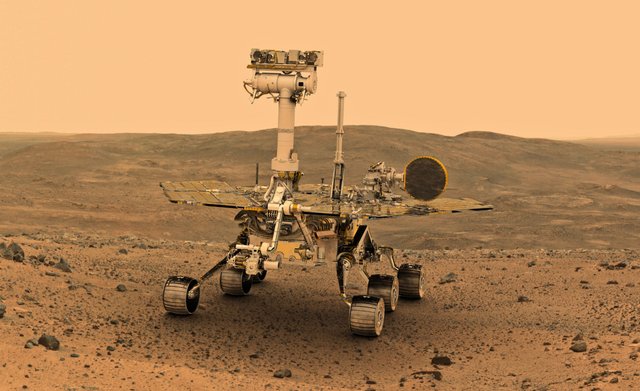
Some dream of the arrival of man on Mars and probably do not remember that a small vehicle has been exploring the red planet for years. NASA rover Opportunity met no less than 5,000 days on Mars last Saturday.
The record is even more surprising if we consider that NASA anticipated that this unique robotic explorer would last about 90 days in operation. Opportunity survived the frigid Martian winter, and it did so thanks to an intelligent maneuver that makes its useful life seem for the moment almost indefinite.
The Martian winter seemed insurmountable
When Opportunity took off from Earth to Mars on July 7, 2003, Xataka did not even exist. He did not do it alone, since a second "twin" rover named Spirit also wanted to explore this planet.

This is the sunset of the Sun (Martian day) 4999 captured by Opportunity's panoramic camera on February 15, 2018. Source: NASA
Both ended up taking land on Mars in January 2004 at opposite points, and when NASA planned the mission it expected both to survive for 90 days.
After that period came winter on Mars, which lasts twice as long as it lasts on Earth. Added to this was the fact that the two rovers landed in the southern hemisphere of Mars, which is not exactly sunny during that winter.
Incline, Opportunity
NASA knew it and did not have high hopes that both could overcome that winter, but then their engineers came up with a prodigious idea: "tilt" the rober to the north to capture as much sunlight as possible during the long season wintry.

Mars is slightly inclined on its rotation jee with respect to its orbit around the Sun. The same happens to the Earth, but on Mars that inclination is 25 degrees by 23.5 degrees of our planet. That means that both planets have similar seasons, but since Mars has a year that is 1.88 times that of Earth, its seasons last almost twice as long as those of our planet.
That makes planning to collect energy through solar panels and their use (movement and data collection by the rover) essential during the Martian winter, when sunlight is scarce and the Sun follows a northern route from the point of view of the rover.
NASA engineers realized that fact and managed to tilt the rover to the north so that the vehicle panels maximized the collection of sunlight in that Martian winter. The miracle happened, and both rovers managed to survive that first Martian winter and continue to explore Mars during the following years.
Spirit ended up losing that battle. This rover could not maintain enough energy to survive when it was already spending its fourth Martian winter in 2009. It was then that it lost two of its wheels - which lasted much longer than had been planned - and got stuck in a sand trap that it prevented him from leaning towards the north to continue subsisting.

Opportunity, however, continued its journey (including remote formats). This rover has been running for months the so-called "Perseverance Valley", and has been positioned optimally to collect data in places where it was then possible to get feedback from sunlight one winter after another.
As the engineers of NASA indicated, the planning is absolutely thorough for Opportunity, so that each task of exploration and data collection is always conditioned by the possibilities of being able to continue subsisting by collecting solar energy in its panels.
This rover "competes" now with the Curiosity rover, which instead of those solar panels makes use of a thermoelectric generator based on a radioisotope.

This photo was taken by Opportunity on May 8, 2012 after traveling the first 4 meters since he was 19 weeks at that critical point where he could recharge his batteries.
Although both rovers suffer from the Martian winter, Opportunity is even more in danger and depends on achieving an optimal position to collect energy. This meant that, for example, between 2011 and 2012, 19 weeks were spent at the same point because there were no other nearby sites where the favorable inclination to collect solar energy was achievable.
Now the worst enemy is the dust
That unique tilt system has made Opportuniy's life much longer than initially expected, but there are more threats that could make his mission come to an end.

This is one of the 46 images that Opportunity sent with its panoramic camera to celebrate its Sun 5000. Congratulations! Source: NASA
The winter sun is certainly one of them, but now NASA engineers fear almost more of the dust that covers the solar panels and reduces efficiency in the energy collection.
Although the Martian wind helps clean these panels, the opposite can also be true: dust storms could bury these panels or rover completely. Those storms occurred in the Martian spring and summer. The last major storm in 2007 saw a significant reduction in energy capture, which caused a significant reduction in its operations and communications.

This is the aspect of the sandstorm that almost condemned both rovers, Opportunity and Spirit, in 2007.
It is expected that the next big dust storm will occur this year, and everyone expects that despite this Opportunity will again prove its integrity. The eighth Martian winter seems to be almost over completely, and the rover wants to continue traveling the surface of Mars (has 45 kilometers since its landing) and sending images (225,000 to date, all public) that amaze us once again.
I remember the landing and everything, and when we got new reports for weeks after the 90days were up and they keept on going. Very interesting post.
Thanks
Downvoting a post can decrease pending rewards and make it less visible. Common reasons:
Submit
It was going to last 90 days, but already it takes 5000 (and going up) very interesting to know that it continues sending photos exploring and this operative ....
Downvoting a post can decrease pending rewards and make it less visible. Common reasons:
Submit